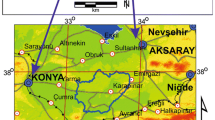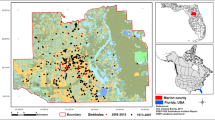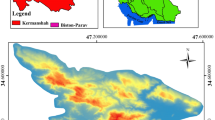Abstract
The occurrence of anthropogenic sinkholes in urban areas can lead to severe socioeconomic losses. A damaged underground sewer pipe is regarded as one of the primary causes of such a phenomenon. This study adopted the best subsets regression method to produce a logistic regression model that evaluates the susceptibility for sinkholes induced by damaged sewer pipes. The model was developed by analyzing the sewer pipe network as well as cases of sinkholes in Seoul, South Korea. Among numerous sewer pipe characteristics tested as explanatory variables, the length, age, elevation, burial depth, size, slope, and materials of the sewer pipe were found to influence the occurrence of sinkhole. The proposed model reasonably estimated the sinkhole susceptibility in the area studied, with an area value under the receiver-operating characteristics curve of 0.753. The proposed methodology will serve as a useful tool that can help local governments to choose a cavity inspection regime, and to prevent sinkholes induced by damaged sewer pipes.


(Courtesy of San Antonio Fire Department)



Similar content being viewed by others
References
Agresti A, Maria K (2003) Categorical data analysis, 2nd edn. Wiley, Hoboken, pp 206–2008
Akaike H (1974) A new look at the statistical model identification. IEEE Trans Autom Control 19(6):716–723
Ariaratnam ST, El-Assaly A, Yang Y (2001) Assessment of infrastructure inspection needs using logistic models. J Infrastruct Syst 7:160–165
Ayalew L, Yamagishi H (2005) The application of GIS-based logistic regression for landslide susceptibility mapping in the Kakuda-Yahiko Moutains, Central Japan. Geomorphology 65:15–31
Bae Y, Shin S, Won J, Lee D (2016) The road subsidence conditions and safety improvement plans in Seoul. The Seoul Institute, Seoul, South Korea, Report 2016-PR-09 (in Korean)
Baur R, Herz R (2012) Selective inspection planning with ageing forecast for sewer types. Water Sci Technol 46(6–7):389–396
Beradi L, Giustollisi O, Kapelan Z, Savic DA (2008) Development of pipe deterioration models for water distribution systems using EPR. J Hydroinform 10(2):113–126
BSI (1998) EN 1610: 1998. Construction and testing of drains and sewers. BSI, London, UK
Bui DT, Pradhan B, Nampak H, Bui QT, Tran QA, Nguyen QP (2016) Hybrid artificial intelligence approach based on neural fuzzy inference model and metaheuristic optimization for flood susceptibility modeling in a high-frequency tropical cyclone area using GIS. J Hydrol 540:317–330
Carbonel D, Rodríguez V, Gutiérrez F, McCalpin JP, Linares R, Roqué C, Zarroca M, Guerrero J, Sasowsky I (2014) Evaluation of trenching, ground penetrating radar (GPR) and electrical resistivity tomography (ERT) for sinkhole characterization. Earth Surf Process Land 39(2):214–227
Ciotoli G, Loreto ED, Finoia MG, Liperi L, Meloni F, Nisio S, Sericola A (2016) Sinkhole susceptibility, Lazio Region, central Italy. J Maps 12:287–294
Code of Federal Regulations 49 CFR 195.248. Cover over buried pipe line
Davies JP, Clarke BA, Whiter JT, Cunningham RJ (2001a) Factor influencing the structural deterioration and collapse of rigid sewer pipes. Urban Water 3:73–89
Davies JP, Clarke BA, Whiter JT, Cunningham RJ, Leidi A (2001b) The structural condition of rigid sewer pipes: a statistical investigation. Urban Water 3:277–286
Del Giudice G, Padulano R, Siciliano D (2016) Multivariate probability distribution for sewer system vulnerability assessment under data-limited conditions. Water Sci Technol 73:751–760
Dou J, Bui DT, Yunus AP, Jia K, Song X, Revhaug I, Xia H, Zhu Z (2015) Optimization of causative factors for landslide susceptibility evaluation using remote sensing and GIS data in parts of Niigata. PLoS ONE, Japan. https://doi.org/10.1371/journal.pone.0133262
Egger C, Scheidegger A, Reichert P, Maurer M (2013) Sewer deterioration modeling with condition data lacking historical records. Water Res 47:6762–6779
Fenner RA (1990) Excluding groundwater infiltration into new sewers. Water Environ J 4:544–551
Galloway D, Jones DR, Ingebritsen SE (1999) Land sunbsidence in the United States, vol 1182. U.S. Geological Survey. Circular, Reston
Gómez-Ortiz D, Martín-Crespo T (2012) Assessing the risk of subsidence of a sinkhole collapse using ground penetrating radar and electrical resistivity tomography. Eng Geol 149:1–12
Guarino PM, Nisio S (2012) Anthropogenic sinkholes in the territory of the city of Naples (Southern Italy). Phys Chem Earth 49:92–102
Guo S, Shao Y, Zhang T, Zhu DZ, Zhang Y (2013) Physical modeling on sand erosion around defective sewer pipes under the influence of groundwater. J Hydraul Eng 139(12):1247–1257
Gutiérrez F, Guerrero J, Lucha P (2008) A genetic classification of sinkholes illustrated from evaporite paleokarst exposures in Spain. Environ Geol 53:993–1006
Gutiérrez F, Parise M, De Waele J, Jourde H (2014) A review on natural and human-induced geohazards and impacts in karst. Earth Sci Rev 138:61–88
Hair JF, Black WC, Babin BJ, Anderson RE, Tatham RL (2006) Multivariate data analysis, 6th edn. Prentice hall, Upper Saddle River, p 557
He Y, Beighley RE (2008) GIS-based regional landslide susceptibility mapping: a case study in southern California. Earth Surf Process Land 33:380–393
Hermosilla RG (2012) The Guatemala City sinkhole collapses. Carbonates Evaporites 27(2):103–107
Hosmer D, Jovanovic B, Lemeshow S (1989) Best subsets logistic regression. Biometrics 45:1265–1270
Indiketiya S, Jegatheesan P, Rajeev P (2017) Evaluation of defective sewer pipe–induced internal erosion and associated ground deformation using laboratory model test. Can Geotech J 54(8):1184–1195
Kaufmann G (2014) Geophysical mapping of solution and collapse sinkholes. J Appl Geophys 111:271–288
Kaufmann G, Romanov D, Nielbock R (2011) Cave detection using multiple geophysical methods: Unicorn cave, Harz Mountains, Germany. Geophysics 76(3):71–77
Korea Meteorological Administration (2011) Regional climate change report on Seoul, Seoul, South Korea (in Korean)
Kuwano R, Horii T, Yamaguchi K, Kohashi H (2010) Formation of subsurface cavity and loosening due to defected sewer pipe. Jpn Geotech J 5:349–361
Kwak TY, Kim KY, Lee MH, Chung CK, Kim J (2017) Evaluation of the effect of burial depth and rainfall intensity on ground cave-in induced by a damaged sewer pipe. In: Proceedings of the 70th Canadian geotechnical conference and the 12th joint CGS/IAH-CNC Groundwater Conference, Ottawa
Lester J, Farrar DM (1979) An examination of the defects observed in 6 km of sewers. TRRL Supplmentary Report 531
Lollino P, Martimucci V, Parise M (2013) Geological survey and numerical modeling of the potential failure mechanisms of underground caves. Geosyst Eng 16(1):100–112
Margiotta S, Negri S, Parise M, Quarta TAM (2016) Karst geosites at risk of collapse: the sinkholes at Nociglia (Apulia, SE Italy). Environ Earth Sci 75(1):1–10
Menard S (1995) Applied logistic regression analysis. SAGE, Thousand Oaks
Menard S (2011) Standards for standardized logistic regression coefficients. Soc Forces 89:1409–1428
Mukunoki T, Kumano N, Otani J, Kuwano R (2009) Visualization of three dimensional failure in sand due to water inflow and soil drainage from defected underground pipe using X-ray CT. Soils Found 49:959–968
O’reilly MP, Rosbrook RB, Cox GC, McCloskey A (1989) Analysis of defects in 180 km of pipe sewers in southern water authority. TRRL Research Report 172
Ohlmacher GC, Davis JC (2003) Using multiple logistic regression and GIS technology to predict landslide hazard in northeast Kansas, USA. Eng Geol 69:331–343
Ozdemir A (2016) Sinkhole susceptibility mapping using logistic regression in Karapınar (Konya, Turkey). Bull Eng Geol Environ 75:681–707
Parise M (2010) The impacts of quarrying in the Apulian karst (Italy). In: Andreo B, Carrasco F, Durán J, LaMoreaux J (eds) Advances in research in Karst media. Environmental Earth Sciences. Springer, Berlin
Parise M (2012) A present risk from past activities: sinkhole occurrence above underground quarries. Carbonates Evaporites 27(2):109–118
Parise M (2015) A procedure for evaluating the susceptibility to natural and anthropogenic sinkholes. Georisk 9(4):272–285
Parise M, Gunn J (eds) (2007) Natural and anthropogenic hazard in karst areas: recognition analysis and mitigation. Geological Society London, Special Publication 279, London
Pourghasemi HR, Moradi HR, Fatemi Aghda SM (2013) Landslide susceptibility mapping by binary logistic regression, analytical hierarchy process, and statistical index models and assessment of their performances. Nat Hazards 69:749–779
QGIS Development Team (2014) QGIS geographic information system. Open Source Geospatial Foundation Project. http://www.qgis.org/
R Core Team (2017) R: a language and environment for statistical computing. R Foundation for Statistical Computing Vienna, Austria. https://www.r-project.org/
Rogers CJ (1986) Sewer deterioration studies: the background to the structural assessment procedure in the sewage rehabilitation manual, 2nd edn. WRc report ER199E
Seoul Metropolitan Government (2015) Maintenance and enhancement of sewage information systems and increase in precision of GIS DB. Sewerage Treatment Planning Division of Seoul Metropolitan Government, Seoul, p D0000021501950
Seoul Metropolitan Government (2016) Seoul statistical yearbook. Data and Statistics Division of Seoul Metropolitan Government, Seoul
Slocum TA, McMaster RB, Kessler FC, Howard HH (2009) Thematic cartography and geovisualization, 3rd edn. Pearson Prentice hall, Upper Saddle River
Tabachnick BG, Fidell LS (2001) Using multivariate statistics, 4th edn. Allyn & Bacon, Boston, pp 524–525
Tang Y (2017) Mechanisms of soil erosion due to defective sewer pipes. Dissertation, University of Alberta
Tehrany MS, Pradhan B, Mansor S, Ahmad N (2015) Flood susceptibility assessment using GIS-based support vector machine model with different kernel types. CATENA 125:91–101
Tran DH, Ng AWM, Perera BJC, Burn S, Davis P (2006) Application of probabilistic neural networks in modelling structural deterioration of stormwater pipes. Urban Water J 3(3):175–184
Truett J, Cornfield J, Kannel W (1967) A multivariate analysis of the risk of coronary heart disease in Framingham. J Chronic Dis 20:511–524
Van Den Eeckhaut M, Vanwalleghem T, Poesen J, Govers G, Verstraeten G, Vandekerckhove L (2006) Prediction of landslide susceptibility using rare events logistic regression: a case-study in the Flemish Ardennes (Belgium). Geomorphology 76:392–410
Wang Z, Lai C, Chen X, Yang B, Zhao S, Bai X (2015) Flood hazard risk assessment model based on random forest. J Hydrol 527:1130–1141
Yamijala S, Guikema SD, Brumbelow K (2009) Statistical models for the analysis of water distribution system pipe break data. Reliab Eng Syst Saf 94:282–293
Yilmaz I (2009) Landslide susceptibility mapping using frequency ratio, logistic regression, artificial neural networks and their comparison: a case study from Kat landslides (Tokat-Turkey). Comput Geosci 35:1125–1138
Yokota T, Fukatani W, Miyamoto T (2012) The present situation of the road cave in sinkholes caused by sewer systems (FY2006~FY2009). National institute for land and infrastructure management, Ministry of Land, Infrastructure, Transport and Tourism, Japan, Report No. 668 (in Japanese)
Zou KH, O’Malley AJ, Mauri L (2007) Receiver-operating characteristic analysis for evaluating diagnostic tests and predictive models. Circulation 115:654–657
Acknowledgements
This work was supported by the National Research Foundation of Korea (NRF) grant funded by the Korea government (MSIP) (No. 2015R1A2A1A01007980).
Author information
Authors and Affiliations
Corresponding author
Rights and permissions
About this article
Cite this article
Kim, K., Kim, J., Kwak, TY. et al. Logistic regression model for sinkhole susceptibility due to damaged sewer pipes. Nat Hazards 93, 765–785 (2018). https://doi.org/10.1007/s11069-018-3323-y
Received:
Accepted:
Published:
Issue Date:
DOI: https://doi.org/10.1007/s11069-018-3323-y




